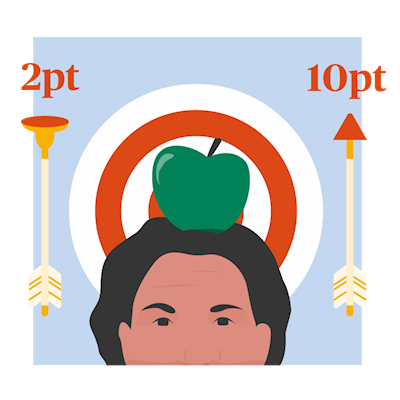Lorna Denny
Risk is not a very comfortable word, but it's one that is intimately associated with investment. In our daily lives, risk is something we might look to avoid. But in the world of investment, risk is closely tied to the returns that we're all looking to earn. Risk in this case becomes a matter, not so much of danger, but of opportunity. And it is all a question of degree.
Today we consider how these two concepts of risk and reward have come to be inextricably linked. Also, how the risk associated with investment can be mitigated and how that process depends on the returns we might be looking to achieve.
There are a number of different categories of financial risk, which investors should really get to grips with. Let's start with the obvious category of market risk.
Patrick Brenner
Market risk is certainly the most common risk that any investor is exposed to because, by definition, market risk is the risk of being invested. It is basically the risk that an investor might experience a change in the value of his or her investment, due to factors which affect the overall performance of the market. The market risk is quite a broad concept, which includes several types of risk like equity risk, interest rate risk, currency risk and commodity risk. And each of those risks represents the risk that the market will move in a way which might affect the value of a specific investment, up or down.
I'm sure a lot of our listeners will have heard the notion of volatility. An interesting point is that market risk is often measured in terms of the volatility of an asset. It basically gives you an estimation of how risky the asset class that you are investing in is. For example, an asset class which has a volatility of 10% will mean that the range of this asset value going up or down would be significantly higher than an asset with the volatility of only 2%. But what is very critical is that market risk is an integral part of any investment. And while market risk can definitely lead to losses, it can also create opportunity and return. So ultimately market risk is really the price you pay for any potential return.
Lorna Denny
Some financial markets are huge, with massive sums of money traded daily. Others are a little narrower, which moves us on to liquidity risk.
Patrick Brenner
Liquidity risk refers to the risk that an investor might not be able to buy or sell an asset at a price which reflects its intrinsic or fundamental value. In other words, it's actually the risk that because of the lack of liquidity, you might be overpaying to buy an asset or being underpaid to sell an asset. Liquidity risk can occur in different instances, such as in a particularly small market where the numbers of buyers and seller is low. But it can also arise in times of market stress, when everyone wants to sell their asset at the same time and there are simply not enough buyers.
You have different degrees of liquidity risk. To give you an example, large company equities are typically much more liquid than those of smaller companies. Equally, government bonds tend to be more liquid than corporate bonds.
What's important is that, similar to market risk, liquidity risk can be both a risk but also an opportunity. It might be harder to sell an asset, but this could provide an opportunity to buy an asset at a discount when others are forced to sell. Over time, if you have a longer time horizon and you can hold an asset for a long period of time, you should get compensated. You should get an extra return for the liquidity risk that you are running.
Ultimately the key when it comes to the liquidity risk is making sure that the liquidity profile of your investment is pretty much aligned with your time horizon. So don't invest in an illiquid asset if you don't know when you might need the money.
Lorna Denny
Inflation has been hogging the headlines since the pandemic and merits its own category of investment risk.
Patrick Brenner
Inflation risk is really the risk that the value of your investment decreases in real terms, which means after taking inflation into account. In an extreme case, it's the risk that the rate of inflation is higher than any return on the investment. And this is particularly relevant for fixed income investments like bonds. Imagine if you own a bond with a fixed return of 2% and inflation rises, the real value of the fixed interest payment of those investments automatically declines.
Cash is another prime example, because over time cash rates tends to be below inflation. So it means that if you keep all your savings in cash, your real purchasing power is likely to fall over time.
On the other hand, other assets like equities for example, might potentially offer some protection against inflation risk. That's because companies might be able to pass on higher costs to the consumer, which will ultimately be reflected in their earnings and price valuation.
An interesting point about inflation risk is that after years, even decades, of low inflation, it's a risk which is now often overlooked by investors. With the return of inflation in developed markets after the pandemic, it has actually become a much more critical risk for investors to consider.
Lorna Denny
On a more general view, could we consider credit risk.
Patrick Brenner
Credit risk is what we also call default risk in our jargon. Credit risk, in extreme cases, is the risk that an investor doesn't get his capital back in its entirety because the counterparty defaults or is unable to pay it back. Again, this is particularly relevant in the bond market, where an investor is essentially the lender. They must rely on the credit quality of the borrower for repayment of the capital. Credit risk is assessed through credit ratings, which are given by credit rating agencies such as Standard and Poor, Fitch or Moodys. These agencies evaluate the borrower's ability to repay the debt, and they then assign a rating that reflects the quality and the level of risk.
Now credit risk, like every other risk, has direct links to the potential return on investment. Typically, a higher credit risk investment will be associated with a higher potential return, because an investor obviously will demand more compensation for taking on more risk. And finally, credit risk is a crucial part of any investment and in that context, diversification can help to mitigate this notion of credit risk.
Lorna Denny
Our final category is concentration risk.
Patrick Brenner
Concentration risk occurs when you have a large portion of your investments in either a single investment, sector or market. Simply put, it is really the risk of having all your eggs in one basket. Concentration risk can definitely increase the potential for large losses. But on the flipside it could also lead to substantial gains, if the concentrated position performs well.
To give you an example, unusually last year in 2023 investors were not rewarded for diversification. They were not rewarded for regional diversification, because the US market was the market which outperformed every other major market. They were not rewarded for sector diversification, because the US market again was driven by only five or six large tech stocks which outperformed all the other sectors. But over time, we should definitely not forget that concentration risk, given the risk of heavy losses, underscores the importance of diversification in an investment portfolio.
Lorna Denny
What do all these different types of risk mean for an investor?
Patrick Brenner
First of all, knowing about these different types of risk can definitely help investors to make more informed decisions about where they want to put their money. They will be able to assess the potential risks which are associated with a particular investment, and they will be able to decide whether this aligns with their own risk tolerance and investment goals.
Secondly, the key is definitely to define your risk tolerance and your return target. What is the risk level you are willing or able to take over a specific time horizon? And let's not forget risk is not altogether bad. You have to be able to take risk in order to make money, so your investment risk profile must be aligned with your ability, but also your willingness to take those risks.
Once an investor is aware of those potential risks, they can probably take steps to mitigate them, and this might involve, as we discussed, diversifying their portfolio, adjusting their investment strategy and targets, or indeed seeking professional advice.
Lorna Denny
How would you choose the level of risk that is not only acceptable, but also the most appropriate for your investment goals.
Patrick Brenner
There are a few simple guidelines. Firstly, understand your investment goal. That is to say, before you can decide on the level of risk, you need to know what you're investing for. Are you saving for retirement? Are you saving for a house, your children's education? And then the time horizon and the importance of those goals can significantly influence your risk tolerance.
Secondly, assess your risk tolerance, which involves understanding how much risk you are comfortable taking on. Some people are more risk averse than others. A number of factors can influence your risk tolerance, including your financial situation, your investment knowledge, but also your emotional comfort with taking on some risk.
And finally, consider your investment horizon. Generally, the longer your investment horizon, the more risk you may be able to take on, because you will have more time to recover from any possible short term losses.
Lorna Denny
How does this lead to a choice between individual asset classes?
Patrick Brenner
Very clearly, different asset classes come with different levels of potential risk and return. Equities, for instance, tend to be riskier, but they can potentially also offer higher return. While bonds on the other hand, are generally considered safer, but typically offer a lower return. I think it is important to understand those characteristics, as this will definitely help you to choose the asset class which aligns your investment goal with your risk.
For example, let's assume your goal is income generation, then you might lean towards bonds or high dividend paying stocks. On the other hand, if your goal is long term growth, you might actually lean more towards equities. And finally, your investment horizon should also come into the equation. If you have a long term investment horizon, you might be able to take on more risk. Which means you will be able to allocate a larger portion of your portfolio to riskier asset classes like equities. But if your investment horizon is rather short, you may need to focus on safer asset classes like bonds or cash equivalents.
Lorna Denny
How does the concept of ‘don’t put all your eggs in one basket’ work in practical terms?
Patrick Brenner
The phrase ‘don't put all your eggs in one basket’ is actually a popular way to express the concept of diversification in the investment world. What does that mean? Well, first think about investing in different asset classes. Spreading your investment across equities, bonds, cash equivalents, but also possibly alternative investments like real estate or commodities. Various asset classes often perform differently under a range of market conditions, so it means that investing in a mix of asset classes can help you to smooth out the return and actually reduce risk. This is what we call the diversification benefit. You should be aware that within an asset class itself, let's say within equities, you can further diversify by investing in different sectors of industry, such as technology, healthcare, consumer goods, and so forth. And this can really help mitigate the risks associated with any one sector.
Another good idea is to invest in a spread of geographical regions, which can further enhance the diversification benefit. And again, this is because various economies might perform differently depending on factors like growth rates, political stability, currency movements and so on.
And finally, it is also possible to diversify over time. Here what we are trying to diversify is the timing of entering the market. It is very often a good idea to try to invest a fixed amount of money at regular intervals, instead of going in in one shot. This is sometimes what we call dollar cost averaging, which allows you to diversify the risk of market timing.
But always remember that while diversification can help you to reduce the risk, it does not guarantee profit or protect against all losses. The important thing is to make sure that you can align your investment with your individual goal, your risk tolerance, and your investment horizon.
Lorna Denny
Let's recap on the five key points
1. Reward and risk are inextricably linked.
2. There are a number of different categories of risk.
3. Each asset class is associated with a particular level of risk.
4. Investment goals are a vital indicator of the most appropriate risk levels.
5. Diversification, that is combining a number of asset classes, each with their own risk level, should help you to achieve your investment goal.
And do look out for the next in our series of Investment Basics podcasts. You can find us on Apple, Spotify, and all leading podcast apps. Search for AXA IM Select Updates and subscribe to our channel. And if you like what you hear, then please do rate our podcast on your chosen platform.











